With the harvest over, last Thursday we made some chateau visits in order to explore the Medoc further. First we went back to Lafon Rochet where Basile gave us a tour of the chateau, letting us taste the juice from the unfermented rosé (for their label Lafon Roset), which was delicious and very easy drinking.
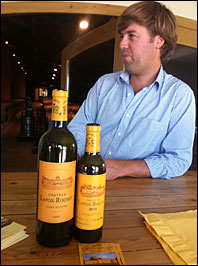
Basile Tesseron and his Lafon Rochet 2009 and 2010
|
After showing us round their barrel cellars and giving us a summary of the chateau’s history, Basile let us taste the 2009 and 2010 wines side by side. The 2009 was charming, forward and fruity with good acidity, ripe red and black fruits and nice spiciness from the oak. It has lots of ripe tannins at this stage and a long, lingering finish. There is no doubting this is a quality wine, and a great effort from the chateau on a par with other 2009s that we have tasted. 2009 is certainly holding up to be the quality vintage proclaimed by all the critics.
The 2010, which is still in barrel, was however the favourite for both of us. The higher levels of acidity and firmer structure combined with layers of lovely fresh black fruit and vanilla. This wine will need more cellaring than the 2009, but for me was really a wine that will reward those who wait. It is the essence of St Estephe, and has real personality that identifies it with this great Medoc village. We were very lucky to taste both of these wines, and, to top it off, Basile gave us a parting gift of two magnums of the 2010 Lafon Roset – I look forward to drinking mine with some sun and good company.
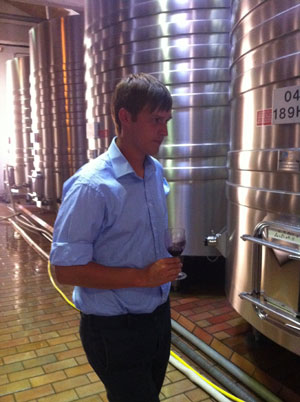
Thomas Parker tasting at Grand Puy Lacoste
|
Next we rushed off to Grand Puy Lacoste, and met Emeline Borie who was kind enough to give us a tour of the Chateau, telling us that they started their harvest on the 15th September, and finished that morning (29th September). Grand Puy Lacoste seem in agreement with most other winemakers at this stage, thinking that the 2011 vintage will be a good one, but not of ‘09/’10 quality. We were also given the privilege of tasting several vat samples, which though in very early stages and still having ‘fizz’ from fermentation, seem quite round and expressive, I look forward to tasting the final product next year. We learnt that the chateau still has all the same vineyards as it did from its 1855 classification, and having had a look through their bottle cellar, which has wines that date back to the 1940s, we went for a tasting at the end of the tour. All wines tasted were in half bottles.
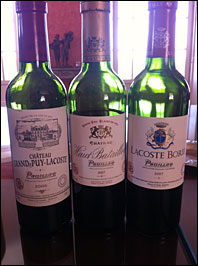
Samples at Grand Puy Lacoste
|
First we tasted the 2007 Lacoste Borie, which was a charming and light style wine, fruity and ready to drink. This second wine of Grand Puy Lacoste is from a selection of grapes that do not make the Grand Vin, and though the wine does not have the structure of its bigger brother, it is certainly a pleasant drink. Secondly we tasted the Haut Batailley 2007, a property managed by GPL in the south of Pauillac bordering St Julien. This wine stepped up the structure from the Lacoste Borie, was nice and spicy as well as having some fresh black fruit, and had a medium finish. The wine in half bottle was ready or just about, but would benefit from a little decanting. Finally we tasted the Grand Puy Lacoste 2005. This wine was dense and concentrated, with lots of fresh black fruit and balanced use of oak, and some bell pepper on the finish. The tannins were more in number and had a chewier texture. This wine will certainly benefit from decanting and from more years of bottle ageing, but will offer those who wait a classic Bordeaux wine at what is a very reasonable price. I know that Farr Vintners are big fans of Grand Puy Lacoste as a wine, and the 2005 is an excellent offering from the chateau.
From Grand Puy Lacoste we headed back to Latour to do a tasting with Jean Garandeau of the 2010s that the chateau has to offer. We started firstly with Pauillac de Latour, which was fresh and fruity, but yet still had some great structure and tannin, and charming crisp acidity. The finish was medium length and one of fresh fruit and vanilla. We moved next to the Forts de Latour 2010. This is a very good effort from the chateau. Immediately on the nose there is a mixture of toasted almonds and nutmeg, with lots of ripe black fruit. On the palate there is a great chewy tannic structure that will need time to settle, crisp and refreshing acidity, and a rush of dense flavours that follow from the aromas. The wine has a long finish. This is a big bold wine that will need a few years cellaring before it will become approachable. It certainly tastes nothing at all like a “second wine”.
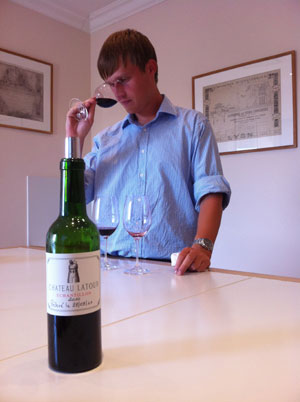
Thomas Parker - after 4 weeks of hard work - one of the perks of the job
|
Finally we moved on to the Grand Vin itself. The 2010 is such a big wine, and the nose is so dense, so big, and with so many fruity, spicy and almost dried herbal layers. The wine explodes on to the palate with massive and chewy tannins, great fresh acidic lift, and moderate alcohol. There are so many flavours that it would be wasteful to describe them all, but fresh and ripe black fruits, layers of vanilla, cinnamon and nutmeg are all evident to name a few, and with such density and clarity. This wine has such a tightly wound and direct structure that it will need more than a decade of cellaring before becoming remotely approachable, and will probably live on longer than both of us! The finish is minutes long, leaving you prizing you lips and cheeks from your teeth and tasting spices and dark fruit that develop on the tongue long after the wine has left your lips; simply staggering.
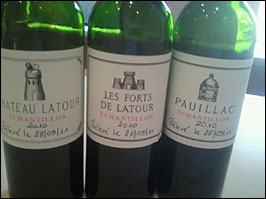
Cask samples of the awesome 2010's
|
Meanwhile, with the grapes all picked, we set to work in the winery itself to watch and to help with the transition from grape juice to wine. More news on that next time.